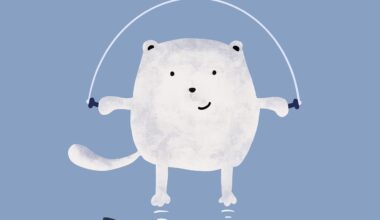Understanding Group Dynamics Through Cat Body Language in Team Sports
In any team sport, understanding body language is crucial to improving communication and cohesion among players. For instance, recognizing the subtle cues given by cats can parallel behaviors observed in human athletes. From tail movements to ear positioning, these signals can illustrate emotional states. Coaches and players should look for similar signals in their teammates. Isolate common behaviors that express eagerness, hesitation, or confidence. This understanding can enhance collaborative strategies, making teams more effective on the field. Moreover, athletes who can read their peers’ body language tend to form deeper connections. Such connections reduce misunderstandings and support collective objectives. Observing a teammate who is visibly nervous can prompt a strategy for encouragement. Similarly, recognizing a player’s aggression can signal the need for intervention. By paralleling observant cat behaviors, players can develop a more attuned sense of teamwork. This awareness can aid in adjusting gameplay based on who is feeling empowered or intimidated. Understanding these dynamics is essential while navigating competitive environments. It ultimately promotes a cohesive unit aiming for victory. Through observing animal behavior, particularly in cats, human players can better grasp emotional intricacies within a team.
Every cat displays distinct body language, serving as a rich dataset to analyze emotional expressions. This analysis does not only inform our comprehension of felines but can analogously be applied to sports teams. For example, a cat displaying relaxed body posture can represent confidence powerful among players. An athlete exhibiting openness, despite high-pressure scenarios, can bolster others’ morale. Conversely, a cat with its ears pinned back signifies anxiety. Such body language can resonate with a player withdrawn within themselves. These signals should prompt teammates to check in or offer support. Recognizing each player’s stance helps the team manage stress collectively, stimulating a more positive environment. Furthermore, similarities can be found in pacing and proximity, with cats often indicating comfort through closeness to others. Understanding the implications of spatial awareness can inform team strategies, such as positioning and support. By cultivating an atmosphere of openness akin to a comfortable feline setting, players can communicate effectively. Notably, deciphering these signals allows athletes to embrace their collective roles and responsibilities. Such comprehension ultimately works toward the overarching goal of team victory and unity amidst challenges faced.
The Importance of Signals in Team Sports
In the realm of sports, signals serve as the cornerstone of teamwork, facilitating unspoken communication. Cats excel in this area, with numerous signals indicating their intentions. For instance, an upright tail signifies friendliness and a desire for interaction, akin to a player reaching out for collaboration. Similarly, a cat crouched low might suggest an upcoming pounce, representing readiness or anticipation in players. Exhibiting similar energy in competitive situations can strengthen a team’s strategy during crucial moments. Each player ought to acknowledge and respond to these dynamic signals to establish a more connected group atmosphere. Facilitating quick understanding improves team performance in critical situations. Furthermore, just like a cat’s flicking tail may indicate annoyance, human frustration should also be recognized. Acknowledging teammates struggling could foster deeper communication about unclear strategies. Thus, an athlete must not only read the action occurring but also the demeanor of their peers. Both facets contribute to developing a finely tuned strategy. This shared understanding allows groups to move seamlessly as one cohesive unit, minimizing the likelihood of errors. Ultimately, studying body language rooted in nature can offer vital insights into team-based dynamics in sports.
A fascinating aspect of cat behavior is their ability to communicate intent through subtle movements. These movements can significantly enhance teamwork in human sports as well. When observing how cats use their tails and eyes, we can draw parallels to how athletes signal plays or strategize silently. For instance, a cat flicking its tail may indicate impatience or eagerness, elements mirrored in competitive players eager to act on a play. Players, too, can convey tactical decisions through small gestures, allowing them to remain coordinated without alerting the opposing team. Recognizing these types of expressions increases awareness and builds a trust factor integral to team success. A keen observation of each member’s feelings strengthens bonds and fortifies strategies. Moreover, these body languages can create advantageous situations by using timing effectively. Just as a cat pauses before pouncing to master its surroundings, players should take time to read their environment before executing plays. The ability to align these instincts can cultivate a pathway leading directly to victory. Learning to translate feline gestures to human interactions can help teams avoid misinterpretations, keeping everyone on the same path towards success.
Reading Stress Signals in Competition
Identifying stress signals in team dynamics is essential for maintaining a positive environment for athletes. Just as cats exhibit clear signs of stress, such as sudden shifts in posture or erratic movements, players likewise show telltale indicators. For example, crossed arms or tight shoulders reflect anxiety among teammates. Recognizing and responding to these signals fosters effective communication, helping those struggling to regain their focus. Creating an atmosphere where players feel safe to express these emotional states is necessary to a team’s success. Open discussion around emotions promotes resilience, strengthening the unit as they face external pressures. Employing techniques witnessed in cats can guide athletes through tumultuous situations. Encouraging open conversation while recognizing stress signs provides valuable insights into potential challenges. Moreover, teams should practice maintaining cohesion during intense moments, much like a harmonious feline group navigation. Through practicing team-building exercises grounded in these principles, athletes can learn to adapt to varying emotional states. Thus, promoting a culture based on empathy encourages a healthier approach to competition. This ultimately leads to enhanced focus, teamwork, and shared victories that everyone can celebrate together.
The role of a supportive team atmosphere cannot be underestimated in sports. Cats are experts at providing comfort to fellow felines through their body language, which helps establish trust within groups. When a cat gently touches its paw to another, it expresses empathy and reassurance. Similarly, players should learn to reach out physically and emotionally when needed. Establishing such comfort can empower teammates, enhancing their capabilities in competitions. Simple gestures, such as a pat on the back or a reassuring nod,go a long way in fostering collaboration. Furthermore, acknowledging these moments bridges gaps among team members, solidifying their connection during high-pressure situations. Players often experience extreme highs and lows during competitions, demonstrating the necessity of mutual understanding. Just like felines employ body language for solace, human teams must develop this notion further to thrive. Through open discussions about each player’s emotional experiences, conflicts can be reduced, ultimately leading to enhanced performance. Thus, creating an empathetic sports environment nurtures continuous growth both individually and collectively. Conclusively, understanding the essence of body language as exhibited in cats offers a refreshing perspective on team sports, emphasizing emotional communication alongside traditional skill development.
Conclusion: Learning from Cats for Team Performance
As we conclude our exploration of cat body language’s significance in team sports, it becomes clear that much can be learned from observing these creatures. Each aspect of feline behavior informs us about the emotional intricacies fundamental to understanding group dynamics. Players who adopt similar observational skills will enhance their ability to communicate effectively and support one another. By implementing techniques akin to nurturing feline interactions, teams can cultivate a more fruitful and robust atmosphere. Promoting openness and understanding encourages sharing individual strengths and weaknesses within groups, allowing athletes to operate harmoniously. Greater cohesiveness leads to elevated performance levels during competitions. More importantly, this approach facilitates deeper interpersonal connections among teammates. Observing and analyzing feline behavior through body language empowers players to recognize vital signals that inform mental states. Fostering these conversations will ultimately shift focus back to teamwork, enriching overall experiences. The compassionate foundation established through these practices will help instill resilience amid challenges faced. This collective engagement can indeed transform a team into a cohesive unit, much like a pride of cats exhibiting solidarity. Thus, recognizing and validating emotional cues can reshape the landscape of team sports for the better.
By synthesizing the unique insights gained from understanding cat body language, athletes can meaningfully enhance their game performance. In conclusion, the lessons drawn from these observant felines take sportsmanship beyond physical agility. They serve as reminders of the emotional connections that underpin every successful team. The quest for better teamwork starts with empathy, situational awareness, and a willingness to support each other. Thus, moving forth, players must commit to nurturing these values in competitive settings. As they do, the benefits will be reflected not just on the scoreboard but also in the unbreakable bonds formed throughout their journey. Whether on the field, court, or any arena, the shared experiences will remind everyone of the essence of teamwork. The attributes of unity, understanding, and emotional intelligence can redefine team dynamics. Through embracing the feline-inspired approach, athletes will develop holistic skills benefiting everyone. It’s not just about playing the game; it’s about building connections that elevate performance. So let’s draw inspiration from our feline friends, allow them to guide our behaviors, and turn our team dynamics from mere cooperation into genuine collaboration as we aim for greatness together.


